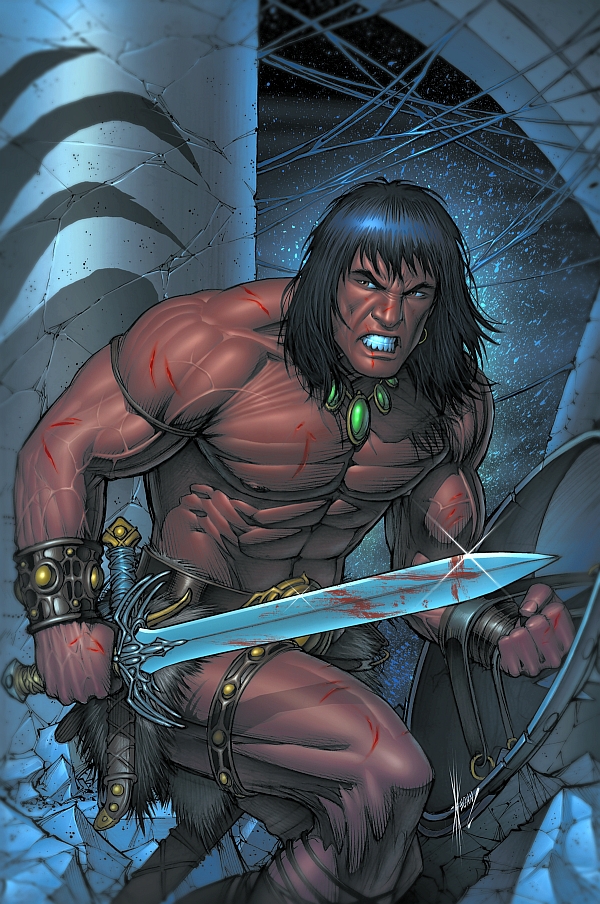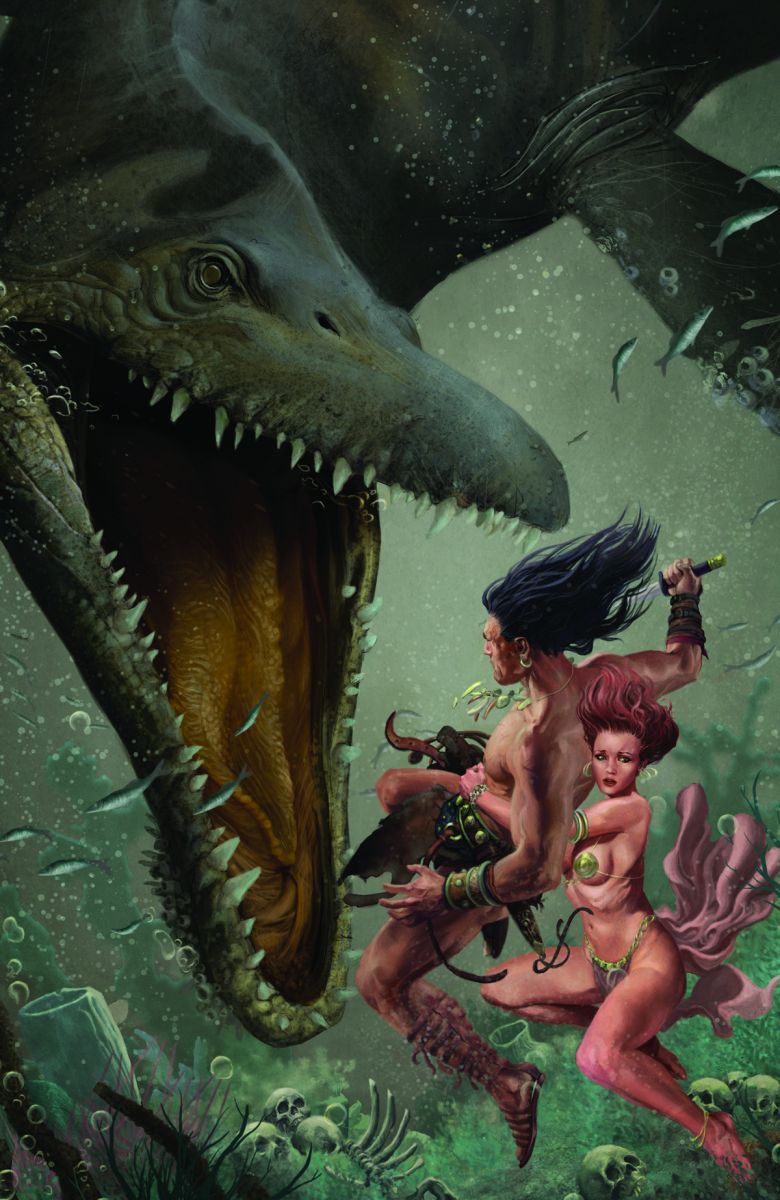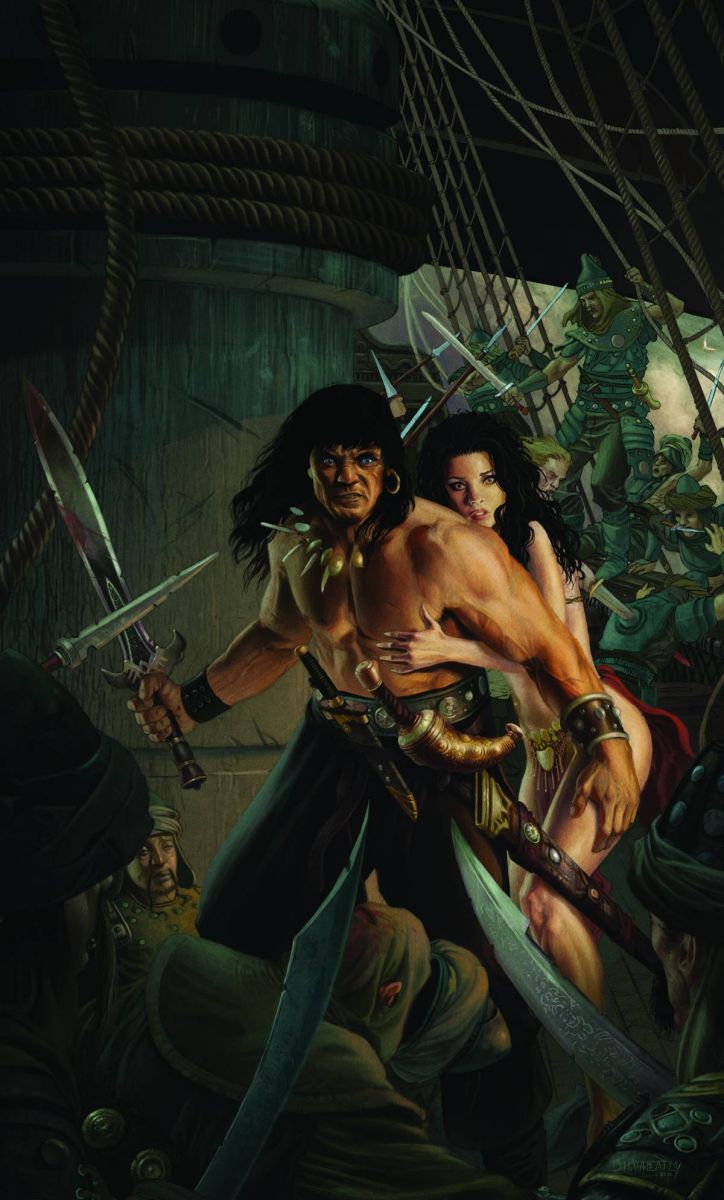 Roy Thomas is one of the founders of modern comics. Throughout his more than 40 years in the industry, he's been known in many roles; first as one of the originators of the comics fan community, then as Stan Lee's right-hand man at the dawn of Marvel Comics and his successor as editor-in-chief, as well as a master of comic book continuity in all forms, particularly in bringing the beloved characters of the Golden Age into today's stories (Roy is credited with bringing the concept of the "retcon" into the comic community consciousness).
Roy Thomas is one of the founders of modern comics. Throughout his more than 40 years in the industry, he's been known in many roles; first as one of the originators of the comics fan community, then as Stan Lee's right-hand man at the dawn of Marvel Comics and his successor as editor-in-chief, as well as a master of comic book continuity in all forms, particularly in bringing the beloved characters of the Golden Age into today's stories (Roy is credited with bringing the concept of the "retcon" into the comic community consciousness).
But even with all that, no accounting of his accomplishments would be complete without mentioning his role in bridging the gap between other forms of literature and the comics medium. The most notable example of that is Roy's decision to bring Robert E. Howard's pulp hero Conan the Barbarian into comics for the first time in 1970. This led to a huge resurgence in the character's popularity, and eventually a couple of movies starring a certain Governator. Roy had two decade-long stints on the character in the '70s and the '90s, making him one of, if not the most prolific Conan writers of all time, but while Conan moved to Dark Horse a few years ago, Roy hasn't been involved with the latest iteration of the character– until now.
Conan: Road of Kings is a 12-issue limited series that covers a previously uncharted time period in the barbarian warrior's epic life. Tales of exotic princesses and bloody sword fights abound, and Roy will be our guide. I spoke with Roy to get a sense of what coming back to the character means for him, and how it may be different this time around.
Matt Adler: Dark Horse has been doing their line of Conan stories for several years now; what made you decide to come on at this juncture?
Roy Thomas: I've always been eager to write Conan again, although I haven't pressed it. But Dark Horse noticed that 2010 was the 40th anniversary of CONAN THE BARBARIAN #1 at Marvel, the first-ever real Conan comic. DH publisher Mike Richardson and I were discussing various special projects, and ultimately Mike decided I should write a 12-issue series.
MA: Where do we find Conan as this story opens? What leads him to travel the Road of Kings?
RT: He just gained his first pirate ship command at the end of the preceding series, as per the finis of REH's story "Iron Shadows in the Moon"–but he immediately loses that (because the episode with Belit on the Black Coast is coming up a year from now, written by other hands) and decides to take Olivia back to her father, the king of Ophir. And the best way–theoretically–to get near Ophir is to travel west on the Road of Kings.
MA: Besides Conan, which characters comprise the cast of this series?
RT: Olivia is prominent in the early issues, but there are also a few surviving crew members of his pirate ship… and a fierce new villain who is virtually a match for Conan in combat.
MA: Are there any particular elements from the original Howard tales that you've drawn upon for this storyline?
RT: Just as I did in the "old days," and as Kurt Busiek and Tim Truman have done in this millennium, there are numerous foreshadowing of future stories, including of the ring "the Star of Khorala" which figures in "Shadows in Zamboula" set years later… plus a few supporting characters. Howard's stories were a rich tapestry, and even if he virtually never carried over characters from one story to another, he left many avenues for us lesser lights to follow when we have to fill in the mortar between the bricks of his classic work.
MA: Can you tell us anything about the kinds of threats Conan and his companions will face along the way?
RT: Creepy-crawlies and things that go bump in the night… plus plenty of human foes, from kings to cutthroats (not always a long journey).
MA: Given the often ambiguous chronology for Howard's Conan stories, did you have any troubles in making your story fit?
RT: No, not once I have the chronology. I was quite happy with the chronology established by Miller & Clark with REH's basic okay in the 30s, but had no problem adjusting.
 MA: Have you been in contact at all with Tim Truman to pave the way for his Conan stories that will follow this series?
MA: Have you been in contact at all with Tim Truman to pave the way for his Conan stories that will follow this series?
RT: No. He didn't contact me, and I didn't contact him. I guess we didn't feel we needed to do so, as the editors can handle that sort of things; David Land is doing an excellent job of coordinating things. There's certainly no friction between us.
MA: Can you tell us a bit about your collaboration with artist Mike Hawthorne? What do you think of what you've seen of his art so far?
RT: He's a fine artist, with a real talent for storytelling. And, given that I'm plotting these stories much as I did stories I wrote in the 70s and 90s (i.e., a bit more densely than the usual comics story today), he's had his hands full getting everything in, but has done it most admirably. He and Doug Wheatley (who's done the early covers) have done a great job, and since we're working what used to be called "Marvel style," their work in turn has influenced my writing and led me in new and, I hope, fruitful directions. I think's it's being a good collaboration, and I hope they're enjoying it, as well. Certainly they're really throwing themselves into their work, and I believe it shows!
MA: It seems the "Marvel-style" of writer-artist collaboration is increasingly rare these days; is that because it's harder to coordinate?
RT: I don't follow current comics closely in general, so I wouldn't know why it became rarer. My feeling is that stories benefit from having the artist be more of the storyteller, but in the end, it's the people involved, not the method, that usually make the difference. I've done most of my work in that style–which is really more the "Stan Lee style"–but have done some scripting the other way, including all the adaptations I did of "X-Files" episodes for Topps back in the '90s, and may do more in the future. But Mike Richardson and I agreed up front that I would handle this CONAN series more or less "my way," so I elected to work in my usual style and several extra weeks were built into the schedule to accommodate this.
MA: What's the biggest difference between Dark Horse's Conan and your work with the character at Marvel?
RT: Understandably and rightly, Dark Horse's Conan has been a bit darker, in ways that weren't right for Marvel in the '70s and '90s, especially in a Code-approved comic. I try to walk a tightrope between that version and "my own," but ultimately I ask myself whether what I'm doing is true to Robert E. Howard, not whether it's true to Thomas, Busiek, or Truman.
MA: Why do you think we root for Conan, even though he's often engaged in some very unsavory activities, including banditry and piracy?
 RT: Because he is, if not always good, at least not really evil. Simply by the act of surviving, he becomes in a sense heroic. And, in spite of himself, he has occasional good inclinations…
RT: Because he is, if not always good, at least not really evil. Simply by the act of surviving, he becomes in a sense heroic. And, in spite of himself, he has occasional good inclinations…
MA: Are there talks about you doing more Conan work for Dark Horse?
RT: Yes, and we'll see how that goes. I'd have loved to do a new and quite different spin on the "Queen of the Black Coast" years, but since that wasn't in the cards, perhaps I can do some other limited series. Mike and I have talked about my adapting a non-Conan REH story into a Conan one, as I did so many times at Marvel… that would be fun, and there are several real possibilities. But I'll confess that a side of me would also like to work with a different REH hero… perhaps a relatively obscure one… and be, as I was with Conan at Marvel, the only person to write that character, and handle it in my own way. Since I turned 70 a couple of weeks ago and have long been officially "retired," I'm in a position where, though I'd love to do more Conan and/or more REH or related subjects, I don't feel pressured to find work. If it comes, it comes, and I relish it… but if not… well, I figure that if I have to write one more comic book story to make safe my small position in the pantheon of comics creators, I'm not gonna make it anyway. Still, I've always loved a challenge, whether it was just writing MILLIE THE MODEL or if it was STAR WARS, CONAN, CADILLACS AND DINOSAURS, or whatever.
MA: What else are you working on these days?
RT: I still work on the SPIDER-MAN newspaper strip with Stan Lee (have since the turn of 1999-2000), and it's always great to be associated with Stan, one of the most important figures in the history of the field… Danny Fingeroth and I are finishing up our TwoMorrows book THE STAN LEE UNIVERSE, which will have a lot of new as well as long-lost material dealing with Stan's career… I'm working with artists Rich Buckler and Nate Furman on a couple of new projects (a World War II super-hero group and a barbarian, you'll be surprised to learn) which we hope to see published soon… there's talk about some literary adaptations for a company other than Marvel… Ron Harris and I are doing a new issue of the ALTER EGO comic book, to go with a 25th-anniversary reissuing of the original four, and this one will carry Alter Ego into the world of 1940s-50s crime comics a la Biro… and there a few other things I can't mention. I try to keep busy, but my wife Dann doesn't like me to work more than 4 days a week nowadays… and I do like to find more time for reading and a social life.
Matt Adler longs to sound his barbaric yawp.



I was putting together my next pre-order for DCBS just the other day and noticed Dark Horse is putting a tooooooooon of the old Conan comics from the ’70s and ’80s out soon. That was all great material.
@flakbait I heard they were reprinting a lot of the old Savage Sword of Conan The Barbarian stuff in color. I’m no so sure how much I’ll like it, but it’s Conan and by Crom I love Conan.
Huh, I wonder who is doing the coloring. That kind of is a bummer. A lot of those comics were oversized, too. We’ll just have to wait and see how they come out.